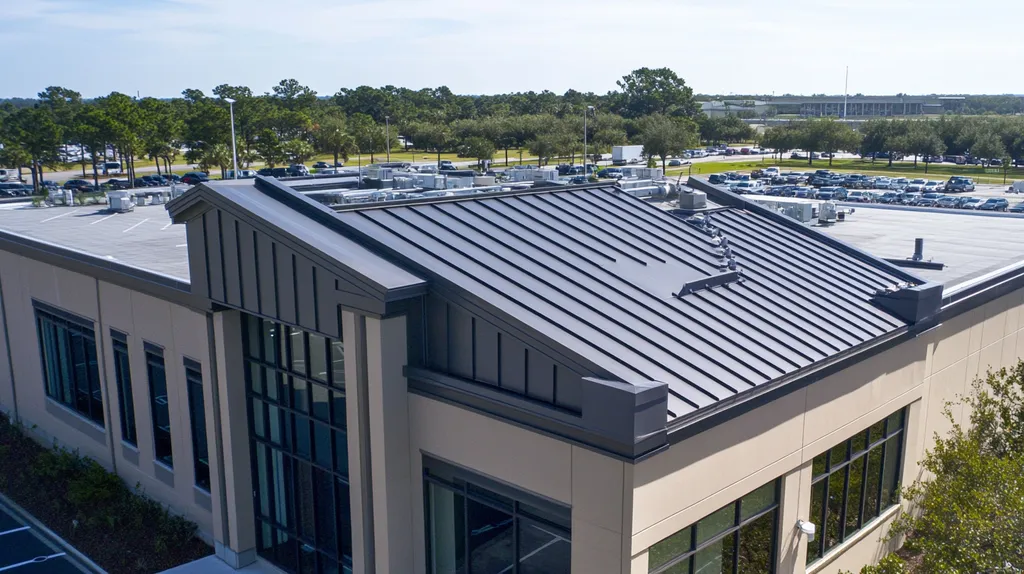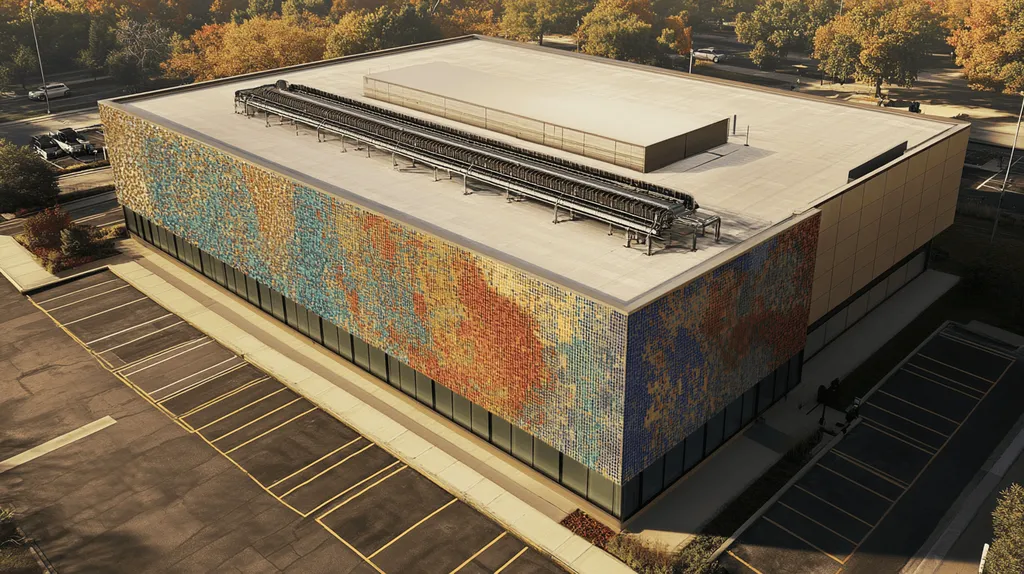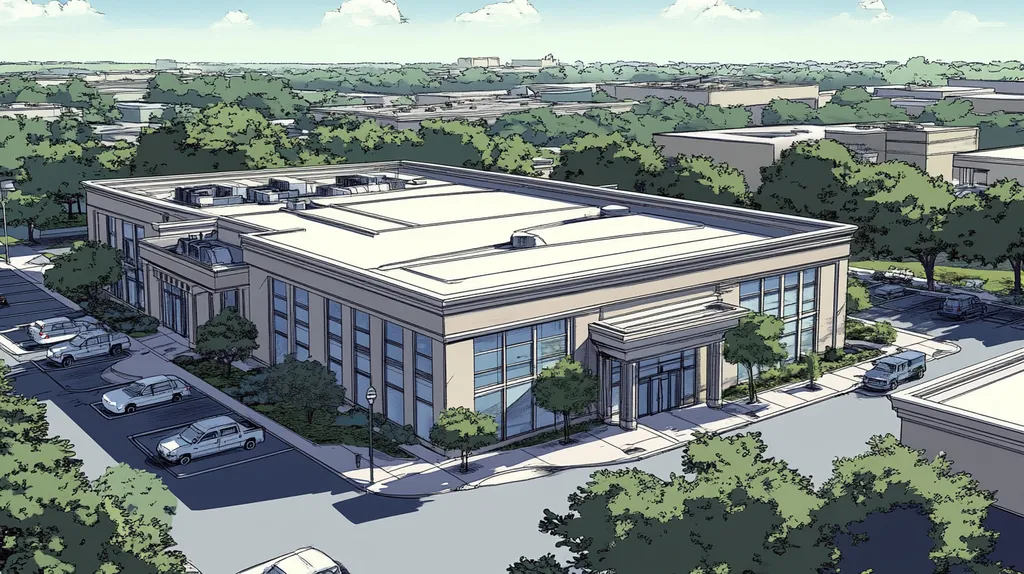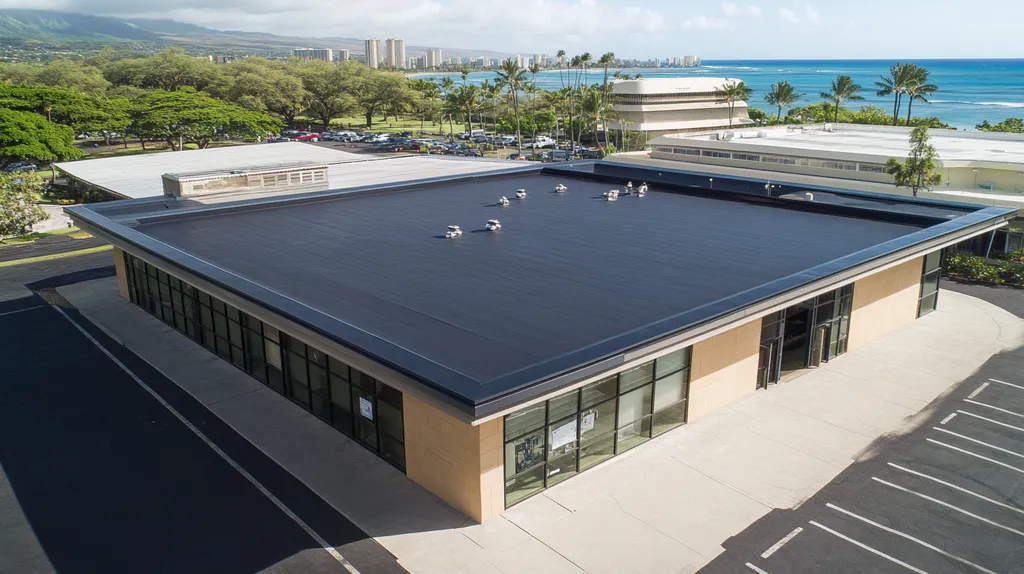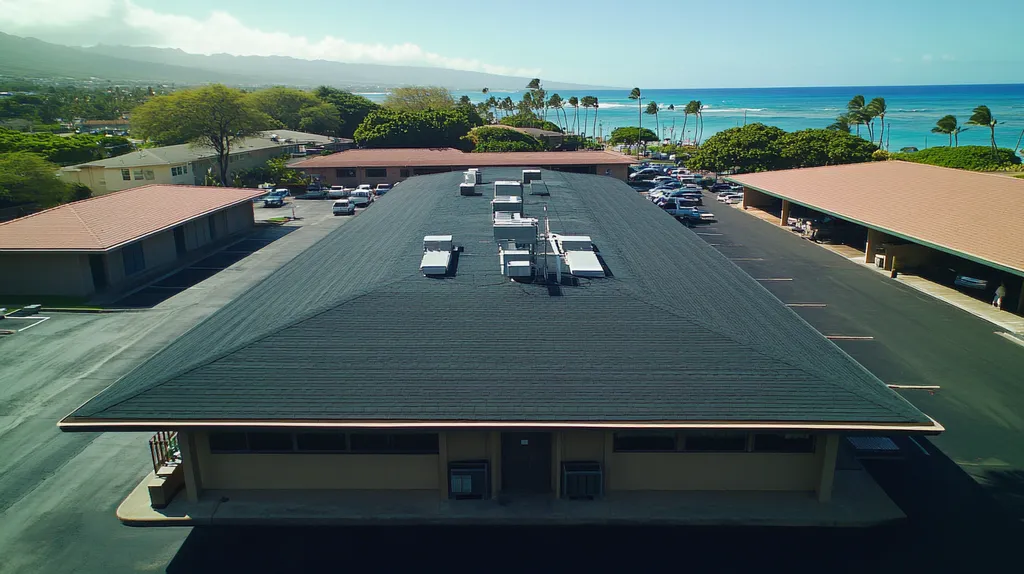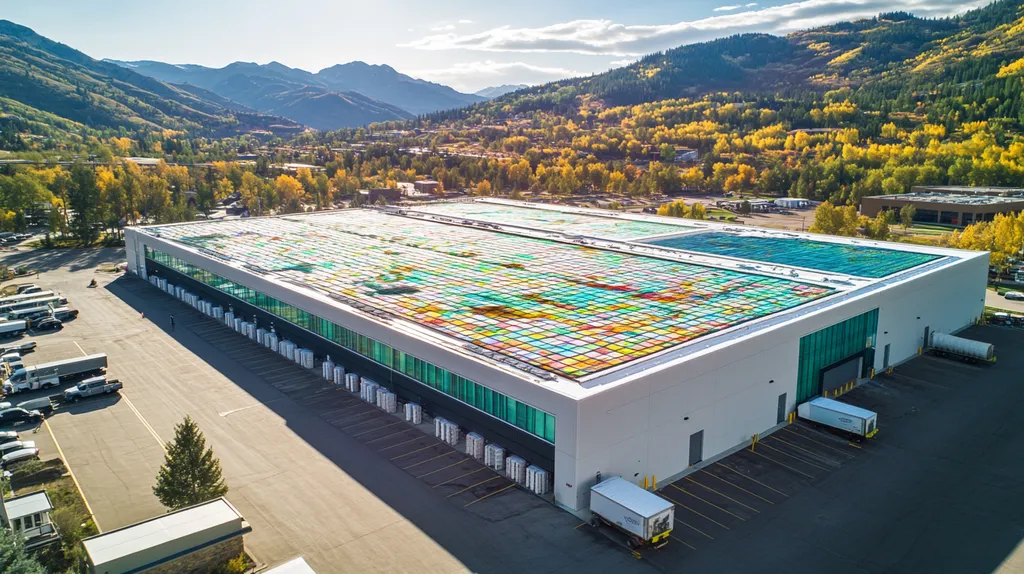Commercial building owners face a troubling reality: up to 40% of roofing warranties fail to adequately protect energy-efficient systems, leaving property managers exposed to millions in potential losses.
While manufacturers tout energy savings of 25-35% from modern roofing solutions, inconsistent standards and conflicting warranty requirements often prevent these systems from delivering on their promises.
This critical examination reveals how current warranty practices undermine energy efficiency goals, creating unnecessary risks for property owners while highlighting opportunities for meaningful reform through advanced materials, integrated systems, and performance-based coverage.
SECTION 1: CURRENT PRACTICES
The commercial roofing industry stands at a critical crossroads where energy efficiency meets practical reality. Building owners face mounting pressure to adopt energy-efficient roofing solutions, with utility costs rising 10-15% annually in many regions. While current standards promise significant savings, they often deliver disappointing real-world results due to oversimplified implementation guidelines and misaligned warranty requirements.
Energy-Efficient Roof Design Standards
Today’s energy-efficient roofing standards emphasize reflectivity and insulation values while often overlooking crucial factors like moisture management and thermal cycling. These standards typically mandate specific R-values and Solar Reflectance Index (SRI) ratings that may not suit all climate zones.
Major certification programs like ENERGY STAR and LEED have established baseline requirements that heavily influence material selection and installation practices. While well-intentioned, these standards can create a one-size-fits-all approach that proves ineffective in diverse climate conditions.
The push for standardization has led to oversimplified specifications that don’t account for building-specific factors such as HVAC placement, roof traffic patterns, and existing structural conditions.
This standardization often results in missed opportunities for customized solutions that could deliver superior energy performance while maintaining long-term durability.
Commonly Used Energy-Efficient Materials
The market currently favors materials that prioritize initial energy performance metrics over long-term durability. Single-ply membranes with high solar reflectance dominate new installations, despite potential longevity concerns in certain applications.
Cool roof coatings and reflective membranes represent the fastest-growing segment of commercial roofing materials. These products can reduce peak cooling demands by 15-25% in warm climates but may increase heating costs in colder regions.
Traditional built-up roofing systems, which often provide superior durability and moisture protection, are increasingly replaced by lighter-weight alternatives marketed primarily for their energy benefits.
This shift has created a concerning trend where immediate energy savings take precedence over system longevity and overall lifecycle costs.
Compliance with Local Building Codes
Local building codes increasingly incorporate energy efficiency requirements, creating a complex web of regulations that vary significantly by jurisdiction. These codes often mandate minimum R-values and reflectivity ratings without considering the practical implications for existing structures.
Many jurisdictions have adopted portions of the International Energy Conservation Code (IECC) without adequate consideration of local climate conditions. This can result in requirements that actually decrease overall building performance in certain scenarios.
Code enforcement typically focuses on initial compliance rather than long-term performance verification. This emphasis on point-in-time metrics fails to ensure sustained energy efficiency throughout the roof’s service life.
The resulting compliance-driven approach often leads to minimal-standard solutions that satisfy code requirements but fall short of optimal energy performance and durability targets.
SECTION 2: SYSTEMIC ISSUES
The commercial roofing industry faces critical challenges that threaten both energy efficiency and long-term sustainability. Poor system integration, inadequate material selection, and inconsistent maintenance practices result in billions wasted annually on premature roof replacements. These systemic issues not only compromise building performance but also create warranty conflicts that leave property owners exposed to substantial financial risk.
Inadequate Insulation and Ventilation
Many commercial buildings suffer from suboptimal thermal performance due to improperly specified or poorly installed insulation systems. When insulation fails to meet performance requirements, energy costs can spike by 25-40% while increasing the risk of condensation and structural deterioration.
Ventilation problems compound these issues by trapping moisture and heat within roof assemblies. Without proper air movement, temperatures in roof cavities can exceed 160°F during summer months, accelerating material degradation and reducing system longevity.
The interaction between insulation and ventilation requires careful balance. Mismatched components or incorrect installation sequences can create thermal bridges and condensation points that bypass even the highest-quality materials.
These fundamental design flaws often go undetected until significant damage occurs, at which point warranty coverage may be compromised due to “improper system design” exclusions.
Limitations of Reflective Roof Coatings
While reflective coatings promise significant energy savings, their real-world performance often falls short of expectations. Surface degradation can reduce reflectivity by 50% within three years, dramatically diminishing energy benefits.
Environmental factors like pollution, biological growth, and UV exposure accelerate coating deterioration. Regular cleaning and maintenance become essential but are frequently overlooked in operating budgets.
Application thickness and substrate preparation critically impact coating performance. Variations of just 25% in mil thickness can reduce service life by half, yet field quality control remains inconsistent.
The industry’s focus on initial solar reflectance values overshadows equally important factors like moisture resistance and adhesion strength, leading to premature coating failure.
Oversight in Maintenance and Inspection
Most energy-efficient roofing systems require specialized maintenance procedures that differ significantly from traditional roofing. Without proper oversight, minor issues quickly escalate into major problems that void warranty coverage.
Inspection protocols often fail to address energy performance metrics. Standard visual inspections may miss degraded insulation values or compromised air barriers that significantly impact building efficiency.
Documentation requirements for warranty compliance frequently exceed typical maintenance records. This gap between required and actual documentation leaves property owners vulnerable to denied claims.
The lack of coordination between facility maintenance teams and roofing contractors creates blind spots in system monitoring. Critical early warning signs go unreported, allowing small problems to develop into costly failures.
SECTION 3: MISSED OPPORTUNITIES
The commercial roofing industry continues to overlook revolutionary technologies that could transform building performance. While property owners focus on traditional energy-efficiency metrics, they’re missing game-changing innovations that deliver both immediate savings and long-term value. By neglecting integrated solutions like vegetative systems, solar integration, and advanced daylighting, buildings waste up to 40% of their total energy consumption through suboptimal roof performance.
Potential of Green Roof Systems
Vegetative roofing systems represent one of the most underutilized opportunities in commercial properties. These sophisticated assemblies can reduce cooling costs by 25-40% during peak summer months while doubling or even tripling roof membrane lifespan.
Modern green roof technology has evolved far beyond simple planted areas. Today’s systems integrate smart irrigation, lightweight growing media, and pre-vegetated modules that dramatically simplify installation and maintenance.
The durability benefits are equally impressive. Vegetative cover protects underlying membranes from UV damage and thermal shock, while advanced drainage layers prevent water damage and root penetration.
Most importantly, green roofs transform unused space into valuable amenities. Properties with accessible green roofs command premium rents and attract quality tenants seeking sustainable, wellness-focused workplaces.
Benefits of Solar Panel Integration
Rooftop solar installation costs have dropped 70% over the last decade, yet most commercial properties still lack integrated photovoltaic systems. Modern solar arrays can offset 60-100% of a building’s electrical load while providing protective shade for the roof surface.
Ballasted mounting systems eliminate roof penetrations and distribute weight loads efficiently. These engineered solutions actually enhance roof performance by reducing thermal stress and UV exposure on membrane surfaces.
The latest bifacial panels capture both direct and reflected light, increasing energy generation by up to 30% compared to traditional modules. This improved efficiency makes solar viable even on roofs with limited usable area.
Combined with federal tax incentives and accelerated depreciation, integrated solar systems typically achieve full payback within 4-6 years while adding substantial property value.
Underutilized Daylighting Systems
Advanced daylighting technologies offer dramatic energy savings potential that most buildings ignore. Properly designed systems can reduce lighting costs by 50-80% while creating more productive, appealing interior environments.
Modern prismatic skylights and light tubes use sophisticated optics to distribute natural light evenly throughout interior spaces. These systems automatically adjust to changing conditions, maintaining optimal light levels without glare or heat gain.
Integration with LED lighting controls maximizes efficiency by seamlessly transitioning between natural and artificial light. This smart approach eliminates the energy waste of overlighting while ensuring consistent illumination.
Beyond energy savings, research shows that natural light improves worker productivity by 5-14% and reduces absenteeism. These indirect benefits often exceed the direct cost savings from reduced electrical consumption.
SECTION 4: ROOT CAUSES
The commercial roofing industry faces a crisis of complexity and confusion that costs property owners millions in wasted energy expenditure. Without clear standards or metrics, building owners struggle to evaluate competing claims about energy efficiency, often resulting in poor investment decisions. This systemic failure leads to approximately 30% higher energy costs across the commercial building sector, while creating unnecessary barriers to adopting proven energy-saving technologies.
Lack of Standardized Energy Efficiency Metrics
The commercial roofing industry currently uses over two dozen different metrics to measure energy performance, creating widespread confusion among property owners. This fragmentation makes it nearly impossible to conduct meaningful comparisons between competing roof systems.
While some manufacturers focus on R-value and thermal resistance, others emphasize solar reflectance index (SRI) or cooling load reduction. These varying approaches prevent property owners from making truly informed decisions about long-term energy performance.
The problem compounds when considering regional climate variations. A roof system that performs excellently in Phoenix may deliver poor results in Chicago, yet current metrics rarely account for these crucial differences.
Without standardized measurement tools, many buildings end up with roofing solutions that deliver suboptimal energy efficiency despite premium pricing. This misalignment drives up operating costs while undermining confidence in energy-efficient technologies.
Inconsistent Enforcement of Regulations
Energy code enforcement varies dramatically across jurisdictions, creating a patchwork of requirements that confuses property owners and contractors alike. Some regions rigorously verify compliance while others perform only cursory reviews.
This inconsistency enables the continued installation of underperforming roof systems that technically meet code requirements but fail to deliver meaningful energy savings. The result is a market flooded with minimally compliant products that ignore opportunities for true efficiency.
The lack of performance verification after installation further weakens accountability. Once a roof receives initial approval, there’s rarely any follow-up to confirm it maintains its energy-efficient properties over time.
Without consistent enforcement and ongoing verification, the market naturally gravitates toward lowest-common-denominator solutions that satisfy paperwork requirements while ignoring real-world performance.
Limited Awareness of Energy-Efficient Options
Most property owners remain unaware of revolutionary roofing technologies that could slash their energy costs by 40-60%. The rapid pace of innovation has created an information gap between available solutions and market understanding.
Traditional specification practices often exclude cutting-edge materials and systems simply because they don’t fit conventional categories. This resistance to innovation keeps superior solutions from reaching widespread adoption.
The complexity of modern roofing systems intimidates many facility managers, leading them to default to familiar but inefficient options. Without better education and support, these decision-makers cannot properly evaluate advanced technologies.
The industry’s failure to effectively communicate the benefits of energy-efficient options perpetuates a cycle of missed opportunities. Property owners continue investing in outdated solutions while transformative technologies remain underutilized.
DATA DRIVEN EVIDENCE
The commercial roofing sector faces a critical inflection point where data reveals stark disparities between conventional and energy-efficient systems. While traditional roofs contribute up to 40% of building energy losses, properly engineered energy-efficient solutions can slash these losses by more than half. However, misconceptions about performance metrics and unclear cost-benefit analyses continue to hinder widespread adoption of superior technologies.
Energy Consumption Patterns and Anomalies
Peak energy demand analysis reveals that poorly designed commercial roofs can increase cooling costs by up to 45% during summer months. This impact becomes especially pronounced in urban heat islands, where ambient temperatures typically run 5-8°F higher than surrounding areas.
Thermal imaging studies demonstrate that conventional dark roofs regularly reach surface temperatures exceeding 170°F, while energy-efficient systems maintain temperatures closer to ambient air. This dramatic difference directly affects HVAC performance and energy consumption patterns.
Building energy monitoring shows that properties with traditional roofing systems experience sharp spikes in energy usage during peak hours. These fluctuations create unnecessary strain on mechanical systems while driving up demand charges.
Most concerning, degradation in conventional roof performance accelerates over time, leading to exponential increases in energy waste. What begins as a 15% efficiency loss can quickly escalate to 40% or more within just 3-5 years.
Cost Savings from Energy-Efficient Upgrades
Detailed analysis of energy-efficient roof installations demonstrates consistent payback periods of 3-7 years through reduced HVAC loads and extended system longevity. These savings compound annually as energy costs continue rising at 2-3 times the rate of inflation.
Properties implementing comprehensive energy-efficient roofing solutions report average reductions of 28-35% in cooling costs during peak summer months. These savings directly impact operating budgets while improving building asset value.
Maintenance costs typically decrease by 40-60% with energy-efficient systems due to better durability and reduced thermal stress. This reduction in repairs and replacement frequency creates substantial long-term value beyond pure energy savings.
Advanced energy-efficient roofing systems consistently outperform traditional solutions in lifecycle cost analysis, delivering 15-20 year average lifespans compared to 8-12 years for conventional systems.
Impact on Occupant Comfort and Productivity
Temperature mapping in commercial spaces reveals that energy-efficient roofing systems reduce thermal variations by up to 65% compared to traditional roofs. This improved stability creates more comfortable working environments while reducing complaints about hot and cold spots.
Measurements of indoor air quality show significant improvements in buildings with proper roof ventilation and thermal management. Reduced heat load through the roof assembly helps prevent moisture accumulation and associated air quality issues.
Workspace productivity studies indicate that stable thermal conditions supported by energy-efficient roofing contribute to 3-7% increases in employee output. These gains stem from reduced temperature fluctuations and better overall comfort levels.
Survey data shows that buildings with energy-efficient roofing systems experience 23% fewer comfort-related complaints and maintain higher tenant satisfaction scores. This improved occupant experience translates directly to better lease retention rates.
SECTION 6: ALTERNATIVE SOLUTIONS
The commercial roofing industry stands at a critical juncture where innovative solutions can dramatically reduce energy waste that costs businesses billions annually. Traditional roofing approaches waste up to 40% of HVAC energy through inefficient thermal management and poor system integration. Forward-thinking facility managers are discovering that alternative roofing solutions deliver both immediate cost savings and long-term value through reduced maintenance and extended system life.
Advanced Cool Roofing Technologies
Phase-change materials (PCMs) represent the next evolution in cool roofing technology, actively managing heat transfer rather than simply reflecting it. These sophisticated materials can absorb excess heat during peak hours and release it during cooler periods, reducing HVAC loads by up to 50% compared to traditional reflective coatings.
Multi-layer composite membranes combine advanced polymers with specialized surface treatments to maintain high solar reflectance even after years of weathering. Unlike conventional cool roofs that lose 20-30% of their reflective properties within three years, these systems retain 90% of their initial performance for a decade or more.
Self-cleaning nanotechnology coatings prevent dirt and biological growth from compromising energy performance. These treatments use photocatalytic reactions to break down surface contamination, maintaining optimal reflectivity without expensive maintenance.
Smart roof membranes with embedded sensors continuously monitor temperature, moisture, and structural integrity. This real-time data enables predictive maintenance while verifying energy performance throughout the roof’s service life.
Integrated HVAC and Roofing Systems
Hybrid roofing systems that combine traditional membranes with advanced air barriers and ventilation layers can reduce peak cooling demands by 35-45%. These assemblies create a dynamic thermal envelope that responds to changing conditions throughout the day.
Strategic placement of rooftop HVAC units within specially designed high-performance zones maximizes equipment efficiency while protecting the roof membrane. This targeted approach can extend both roof and equipment life by 40% or more.
Advanced control systems coordinate roof ventilation with HVAC operation, automatically adjusting airflow patterns to optimize energy efficiency. This intelligent management prevents the energy waste common with standalone systems.
Recovery ventilators integrated into the roof assembly capture waste heat from exhaust air, reducing heating costs by 20-30% in cold climates while maintaining proper moisture control.
Incentives and Rebates for Energy Efficiency Upgrades
Federal tax incentives now cover up to 30% of qualified energy-efficient roofing improvements through programs designed to accelerate commercial building upgrades. These incentives apply to both materials and installation costs, significantly reducing initial investment requirements.
State and local programs often provide matching funds that can double or triple available federal incentives. Many jurisdictions offer expedited permitting and reduced fees for projects that exceed minimum energy efficiency requirements.
Utility companies increasingly offer demand response programs that reward buildings with integrated roof-HVAC systems. These programs can generate additional revenue streams while reducing peak energy costs.
Performance-based incentives tied to verified energy savings provide ongoing returns rather than just upfront rebates. This approach ensures long-term value while encouraging proper system maintenance.
Moving Forward
The commercial roofing industry stands at a critical crossroads, with up to $4.2 billion in annual energy waste directly attributable to inadequate warranty standards and misaligned efficiency metrics.
Without meaningful reform in how warranties address energy performance, property owners will continue facing unnecessary risks while missing opportunities for transformative savings.
The path forward requires three essential changes: standardized energy efficiency metrics that account for regional variations, performance-based warranty coverage that protects long-term efficiency, and integrated system approaches that optimize total building performance.
By embracing these reforms, the industry can finally deliver on the promise of energy-efficient roofing while providing property owners the protection they deserve in an era of rising energy costs and climate uncertainty.
FREQUENTLY ASKED QUESTIONS
Q. How do current energy standards affect commercial roof performance?
A. Current energy standards often focus on basic metrics like reflectivity and R-values without considering unique climate conditions. This oversimplification can lead to underperforming systems that don’t meet the real needs of a building. As a result, property owners may invest in solutions that fail to deliver expected energy savings.
Q. What systemic issues affect industrial roof warranties?
A. Systemic issues such as improper insulation and ventilation often compromise energy efficiency and roof warranties. Many roofs face premature failures due to poorly designed systems that create moisture retention and thermal stress. These flaws lead to conflicts with warranty coverage, leaving property owners vulnerable to unexpected expenses.
Q. What are the benefits of green roofs for commercial properties?
A. Green roofs significantly reduce cooling costs by up to 40% while enhancing roof longevity. They protect underlying membranes from harsh elements and transform otherwise unused space into attractive amenities. By incorporating advanced technologies, green roofs also offer opportunities for better tenant engagement and higher property value.
Q. Why are there inconsistencies in energy efficiency metrics for commercial roofs?
A. The lack of standardized energy efficiency metrics creates confusion among property owners when evaluating roofing options. Different manufacturers promote varying metrics, such as R-value or SRI, making it challenging to compare systems effectively. This inconsistency can result in suboptimal choices that fail to deliver desired energy savings.
Q. What cost savings can be expected from energy-efficient roofing upgrades?
A. Energy-efficient roofing upgrades can provide paybacks within 3-7 years through significant reductions in HVAC loads and maintenance costs. Properties typically experience cooling cost reductions of 28-35% during peak summer months. Moreover, the extended lifespan of energy-efficient systems enhances overall value, making the initial investment worthwhile.
Q. How can advanced roofing technologies improve energy management?
A. Advanced roofing technologies, such as phase-change materials and smart membranes, enhance energy management significantly. These systems actively manage heat transfer and monitor conditions, streamlining energy efficiency. By reducing peak loads and improving thermal stability, these innovations can lower energy costs and extend the roof’s operational life, optimizing overall performance.
Q. What types of warranties are available for commercial roofs?
A. There are generally two main types of warranties for commercial roofs: material warranties and workmanship warranties. Material warranties cover defects in the roofing materials, while workmanship warranties protect against issues arising from the installation process. Understanding these distinctions is crucial for property owners to ensure their investment is well protected.

